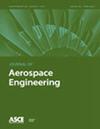Conceptual Assessment of a Lipid-Based Liquid Water Storage System for Lunar Life Support and Exploration
IF 1.6
4区 工程技术
Q2 ENGINEERING, AEROSPACE
引用次数: 1
Abstract
Human lunar and planetary exploration can be simplified by the exploitation of in situ resources. High priorities are placed on propellant and life support consumables, such as oxygen and water. The latter can be considered a biproduct of propellant production, and is essential for sustained human presence. Its existence was detected on the Moon and on Mars. However, its endemic occurrence as ice can make storage and transportation difficult, so a conversion to its liquid state often is preferable. The disadvantage of this is that energy-intensive active heating systems are required to prevent freezing. Recently, a method was presented that potentially can eliminate this disadvantage by maintaining the liquid state down to −120°C, even at pressures as low as 0.1 mbar. This is achieved by mixing the water with a commercially available lipid, thereby forming a lipidic mesophase. Transportation of the mesophase in cryogenic hydraulic networks is achieved easily by pumping, and this can be exploited to design a centralized closed-loop liquid water storage system for a lunar base. The distinguishing feature is that the tanks can be placed outside the human habitats. Key system components are potentially manufacturable in situ. In this work, an architecture for the life support part of such a system is proposed, and the key chemical processes are demonstrated experimentally. The first of these is the scale-up of the water–lipid enrichment process by a factor of 5 from typical laboratory scales. The second is the extraction of water from the mesophase by distillation. It is shown that 79% by weight of the water is extractable for reuse, and the remainder presumably forms an azeotrope with the lipid. The power required to circulate the mixture between human habitats and external tanks is estimated to be <41 kW for a crew of 10.Practical ApplicationsWater can be mixed with a commercially available lipid using a simple thermal process. A surprising attribute of this mixture is that it remains liquid, i.e., it does not freeze, at temperatures as low as −120°C. As a result, pumps can be used to transport the liquid through hydraulic networks. This can be exploited to construct water supply and storage networks in cold environments without the need for an active heating system. Potential applications of this technology are in extraterrestrial and terrestrial environments. The former includes the development of lunar and planetary installations for life support and exploration as part of the ongoing effort to extend human presence beyond Earth. The latter include water storage and supply systems for cold terrestrial environments in which access to clean liquid water is required but such water scarce. Examples are regions above the Arctic circle, Antarctica, high-altitude environments, or, generally, regions with extended freezing periods.用于月球生命维持和探测的基于脂质液态水储存系统的概念评估
人类的月球和行星探测可以通过就地资源的开发来简化。推进剂和维持生命的消耗品,如氧气和水,是重中之重。后者可以被认为是推进剂生产的双产物,对人类的持续存在至关重要。在月球和火星上都发现了它的存在。然而,它以冰的形式出现的地方性会给储存和运输带来困难,因此将其转化为液态通常是可取的。这样做的缺点是需要能源密集型的主动加热系统来防止冻结。最近提出了一种方法,即使在低至0.1 mbar的压力下,也可以通过将液态保持在- 120°C来消除这一缺点。这是通过将水与市售的脂质混合来实现的,从而形成脂质中间期。在低温水力网络中,中间相的输送可以通过泵送来实现,这可以用来设计一个集中的闭环月球基地液态水储存系统。其显著特点是,这些水箱可以放置在人类栖息地之外。关键的系统部件有可能就地生产。在这项工作中,提出了这种系统的生命维持部分的架构,并通过实验证明了关键的化学过程。首先是将水-脂质富集过程放大5倍。第二种是通过蒸馏从中间相中提取水。结果表明,按重量计,79%的水可提取再利用,其余部分可能与脂质形成共沸物。对于10名乘员来说,在人类栖息地和外部储罐之间循环所需的电力估计小于41千瓦。实际应用水可以通过简单的热过程与市售的脂质混合。这种混合物的一个令人惊讶的特性是,它在零下120摄氏度的低温下仍保持液态,也就是说,它不会冻结。因此,泵可用于通过液压网络输送液体。这可以用于在寒冷环境中建造供水和储存网络,而不需要主动加热系统。这项技术的潜在应用是在地外和地球环境中。前者包括月球和行星设施的发展,以维持生命和探索,作为将人类存在扩展到地球以外的持续努力的一部分。后者包括用于寒冷陆地环境的水储存和供应系统,在这种环境中需要获得清洁的液态水,但这种水很少。例如北极圈以上的地区、南极洲、高海拔环境,或者通常是冰期延长的地区。
本文章由计算机程序翻译,如有差异,请以英文原文为准。
求助全文
约1分钟内获得全文
求助全文
来源期刊

Journal of Aerospace Engineering
工程技术-工程:土木
CiteScore
2.90
自引率
4.20%
发文量
149
审稿时长
6.4 months
期刊介绍:
The Journal of Aerospace Engineering promotes the implementation and development of space and aerospace technologies and their transfer to other civil engineering applications. Topics of interest include aerodynamics, computational fluid dynamics, wind tunnel testing of buildings and structures, aerospace structures and materials, advanced composite materials, dynamics and control, real-time data acquisition, space engineering and construction, lunar base construction, field and remote sensing, and robotics.
 求助内容:
求助内容: 应助结果提醒方式:
应助结果提醒方式:


